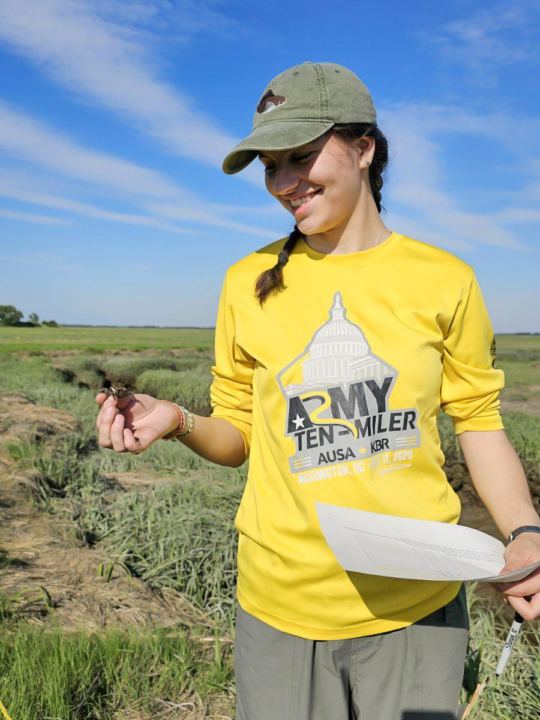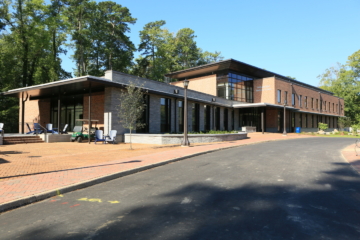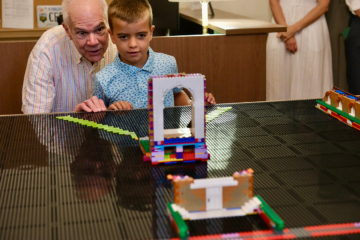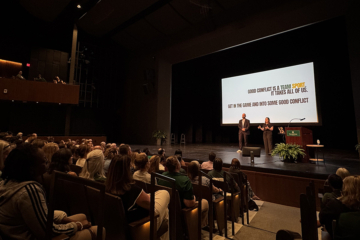Introduction to Marine Science: A growing gateway to coastal careers
The following story originally appeared on the website for William & Mary’s Batten School & VIMS. – Ed.
Professor Mark Brush, a coastal ecosystems ecologist at William & Mary’s Batten School & VIMS, is in his element lecturing to more than 150 students in the Integrated Science Center’s auditorium. He queues up a song, dims the lights and soon students are waving their cell-phone flashlights in unison as an animated video sums up the last few classes on the role of phytoplankton in the ocean.
Brush’s former students’ only gripe: He no longer has a grand piano in the classroom to serenade them since the course outgrew its former space in Andrews Hall, a building primarily occupied by the Department of Art & Art History.
“At its core, marine science is this amazing, interdisciplinary field that helps explain how our entire planet works,” Brush said. “Regardless of their course of study, I want students to feel that excitement when they walk out of my class.”
Brush’s enthusiasm is at the heart of Introduction to Marine Science, which provides undergraduates an overview of geological, physical, chemical and biological ocean processes while deliberately weaving in social sciences, the humanities and the impacts of humans. Brush sought to grow and put his own spin on the course when he took it over in 2022, and, since then, it has more than tripled in size. Not only does it serve as a gateway for students minoring in marine science or pursuing William & Mary’s new undergraduate degree in coastal and marine sciences, it is also one of the most popular electives on campus.
“I always had my eye on this course, because in many ways it’s where I got my start in the field,” said Brush, who served as a teaching assistant in an introductory oceanography course for two years when he was completing his undergraduate degree at Cornell. “That experience made me fall in love with marine science, so this feels like coming full circle.”
Balancing an engaging elective with curriculum requirements
Brush joined the Batten School & VIMS as a faculty member in 2006. He is an expert in ecosystem ecology, particularly in how nutrients, carbon and energy move through coastal systems like the Chesapeake Bay and Virginia’s Eastern Shore. And while he also teaches graduate-level courses, his intro course reaches undergraduates pursuing a variety of subjects.
“I have students from across the board. STEM majors and those interested in our major and minor, yes, but also students from numerous majors outside the natural sciences and those who have never been exposed to marine science before,” said Brush. “And that’s the beauty of teaching this course. I try to make the class as broadly accessible as possible because all students can benefit from literacy in marine science—we all need to understand how vital the oceans are to life on Earth—and we need people from all disciplines to find solutions to our most pressing environmental problems.”
This far-reaching philosophy is baked into the syllabus. While technically a 300-level course designed to prepare students for more advanced marine science offerings, it is also offered as a COLL 200 course as part of W&M’s interconnected College Curriculum. This makes it accessible to all undergraduates requiring nine COLL 200 credits.
Homework assignments are often built around real-world data and require students to analyze, interpret and graph findings using basic tools like spreadsheets—practical skills that mimic work performed by scientists.
“It’s a big class, which makes it difficult to conduct labs, so some of the assignments are designed as self-directed, auto-tutorial labs. I try to put real-world data into the students’ hands and help them develop practical skills that reinforce the concepts they’re learning in class and add to their broader toolbox,” said Brush.
Launching lifelong journeys
Recent graduate Sarah Herrera said the course changed her academic trajectory—read more about her journey in this companion profile.

“I knew I wanted to be involved in environmental science coming into college, but I never considered marine science until I took Mark’s course,” said Herrera, who earned her degree in biology while minoring in marine science and serving as co-president of W&M’s Marine Science Society. “The overlap between land and sea really intrigued me, and now I plan to study sea level rise when I enter the master’s program at the Batten School this fall.”
Maclaren Johnson is a rising senior who chose William & Mary because of her interest in marine science and its connection to the Batten School & VIMS.
“The intro course was a lot of fun, but it also provided a strong foundation in coastal and marine sciences that I continue to use in field work and other courses,” said Johnson, who has taken full advantage of opportunities to engage in marine science during her undergraduate experience, including publishing a study detailing the northern range expansion of the lady crab due to ocean warming while working in the laboratory of Professor David S. Johnson. “I remember people recommending the course to me when I was a freshman, and now I recommend the class all the time.”

Maclaren Johnson studying the northern migration of lady crabs while working in the laboratory of Professor David S. Johnson.
Maclaren Johnson studying the northern migration of lady crabs while working in the laboratory of Professor David S. Johnson.
A biology major, Johnson is considering declaring a minor in marine science and is excited by W&M’s new undergraduate major in coastal & marine sciences. “The timing didn’t work out for me to apply to the new major, but I do hope to pursue a Ph.D. in a field related to coastal marine ecology and, hopefully, grow up to be like some of the awesome mentors I’ve had at William & Mary,” she said.
Brush relishes the opportunity to shape the trajectories of students like Johnson and Herrera. “There are a few of us who are fortunate to serve as frontline faculty for undergraduates being exposed to coastal and marine sciences for the first time. It’s such a privilege to be that link between campuses, to spark students’ interests and connect them with researchers’ labs and other opportunities to get them into the field,” he said.
By making these connections, Brush and other Batten School faculty are helping to ensure future generations will carry forth a passion and appreciation for the world’s oceans and coastal ecosystems that are so crucial to our future.
Latest W&M News
- Student Health Center continues exceptional student care with AAAHC reaccreditationAAAHC accreditation, held by only seven universities in Virginia, recognizes the university's commitment to providing exceptional student-centered care.
- Brick by brick: W&M community to build model of its Historic CampusWilliam & Mary has launched a yearlong project to build a Lego model of its Historic Campus with the help of students, faculty, alumni and the Williamsburg community.
- Finding meaning in the danger zoneDavid Long explores how near-death experiences transform work through storytelling.
- Conflict as a catalyst for growth: W&M’s 2025 Professional Development DaysWilliam & Mary’s second annual Professional Development Days focused on navigating conflict.
- Energy sector leader Darpan Kapadia ’95 to speak at Opening ConvocationDarpan Kapadia ’95 will welcome new William & Mary students this month at Opening Convocation.
- Strategic Cultural Partnerships Faculty Fellows reshape America’s founding story as 2026 approachesEight W&M faculty awarded SCP fellowships to enrich historical narratives and strengthen civic leadership ahead of nation’s 250th anniversary.













